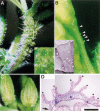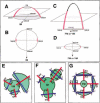A homeobox gene, PRESSED FLOWER, regulates lateral axis-dependent development of Arabidopsis flowers
- PMID: 11751640
- PMCID: PMC312850
- DOI: 10.1101/gad.931001
A homeobox gene, PRESSED FLOWER, regulates lateral axis-dependent development of Arabidopsis flowers
Erratum in
- Genes Dev 2002 Mar 15;16(6):764
Abstract
It is postulated that the symmetric organization of plant lateral organs is based on two crossed axes, the abaxial-adaxial and the lateral axes. The PRESSED FLOWER (PRS) gene, the expression and function of which are dependent on the lateral axis, is reported in this study. In the prs mutant, growth of the lateral sepals is repressed, and although the size and shape of the abaxial and adaxial sepals are normal, the cell files at the lateral margins are missing. Double-mutant analyses showed that the PRS gene functions independently of the determinations of both floral organ identity and floral meristem size. The PRS gene, encoding a putative transcriptional factor with a homeodomain, was shown to be required for cell proliferation. PRS gene expression is spatially and temporally unique and is expressed in a restricted number of L1 cells at the lateral regions of flower primordia, floral organ primordia, and young leaf primordia. Our study strongly suggests that the PRS gene is involved in the molecular mechanism of lateral axis-dependent development of lateral organs in Arabidopsis.
Figures





Similar articles
-
ULTRAPETALA1 encodes a SAND domain putative transcriptional regulator that controls shoot and floral meristem activity in Arabidopsis.Development. 2005 Mar;132(5):897-911. doi: 10.1242/dev.01642. Epub 2005 Jan 26. Development. 2005. PMID: 15673576
-
Spatially and temporally regulated expression of the MADS-box gene AGL2 in wild-type and mutant arabidopsis flowers.Plant Mol Biol. 1994 Oct;26(2):581-95. doi: 10.1007/BF00013745. Plant Mol Biol. 1994. PMID: 7948914
-
The maize duplicate genes narrow sheath1 and narrow sheath2 encode a conserved homeobox gene function in a lateral domain of shoot apical meristems.Development. 2004 Jun;131(12):2827-39. doi: 10.1242/dev.01164. Development. 2004. PMID: 15169755
-
[Transcriptional network during flower development: from homeotic genes to genes controlling morphogenesis in Arabidopsis].Tanpakushitsu Kakusan Koso. 2005 Mar;50(3):228-38. Tanpakushitsu Kakusan Koso. 2005. PMID: 15773303 Review. Japanese. No abstract available.
-
Turning floral organs into leaves, leaves into floral organs.Curr Opin Genet Dev. 2001 Aug;11(4):449-56. doi: 10.1016/s0959-437x(00)00216-1. Curr Opin Genet Dev. 2001. PMID: 11448632 Review.
Cited by
-
Arabidopsis floral phytomer development: auxin response relative to biphasic modes of organ initiation.J Exp Bot. 2014 Jul;65(12):3097-110. doi: 10.1093/jxb/eru153. Epub 2014 Apr 17. J Exp Bot. 2014. PMID: 24744428 Free PMC article.
-
Identification and Functional Divergence Analysis of WOX Gene Family in Paper Mulberry.Int J Mol Sci. 2017 Aug 16;18(8):1782. doi: 10.3390/ijms18081782. Int J Mol Sci. 2017. PMID: 28813005 Free PMC article.
-
The CLV3 Homolog in Setaria viridis Selectively Controls Inflorescence Meristem Size.Front Plant Sci. 2021 Feb 15;12:636749. doi: 10.3389/fpls.2021.636749. eCollection 2021. Front Plant Sci. 2021. PMID: 33659018 Free PMC article.
-
Flower development.Arabidopsis Book. 2010;8:e0127. doi: 10.1199/tab.0127. Epub 2010 Mar 23. Arabidopsis Book. 2010. PMID: 22303253 Free PMC article.
-
Transcriptome-wide identification and characterization of WUSCHEL-related homeobox (WOX) gene family in Pinus yunnanensis.BMC Genomics. 2025 Feb 3;26(1):99. doi: 10.1186/s12864-025-11271-z. BMC Genomics. 2025. PMID: 39901066 Free PMC article.
References
-
- Abe M, Takahashi T, Komeda Y. Identification of a cis-regulatory element for L1 layer-specific gene expression, which is targeted by an L1-specific homeodomain protein. Plant J. 2001;26:487–494. - PubMed
-
- Bossinger G, Smyth DR. Initiation patterns of flower and floral organ development in Arabidopsis thaliana. Development. 1996;122:1093–1102. - PubMed
-
- Bowman JL. Morphology of the expanded first leaves. In: Bowman JL, editor. Arabidopsis: An atlas of morphology and development. New York, NY: Springer-Verlag; 1994. pp. 38–39.
-
- ————— Genetic interactions among floral homeotic genes of Arabidopsis. Development. 1991;112:1–20. - PubMed
Publication types
MeSH terms
Substances
LinkOut - more resources
Full Text Sources
Other Literature Sources
Molecular Biology Databases
Research Materials
